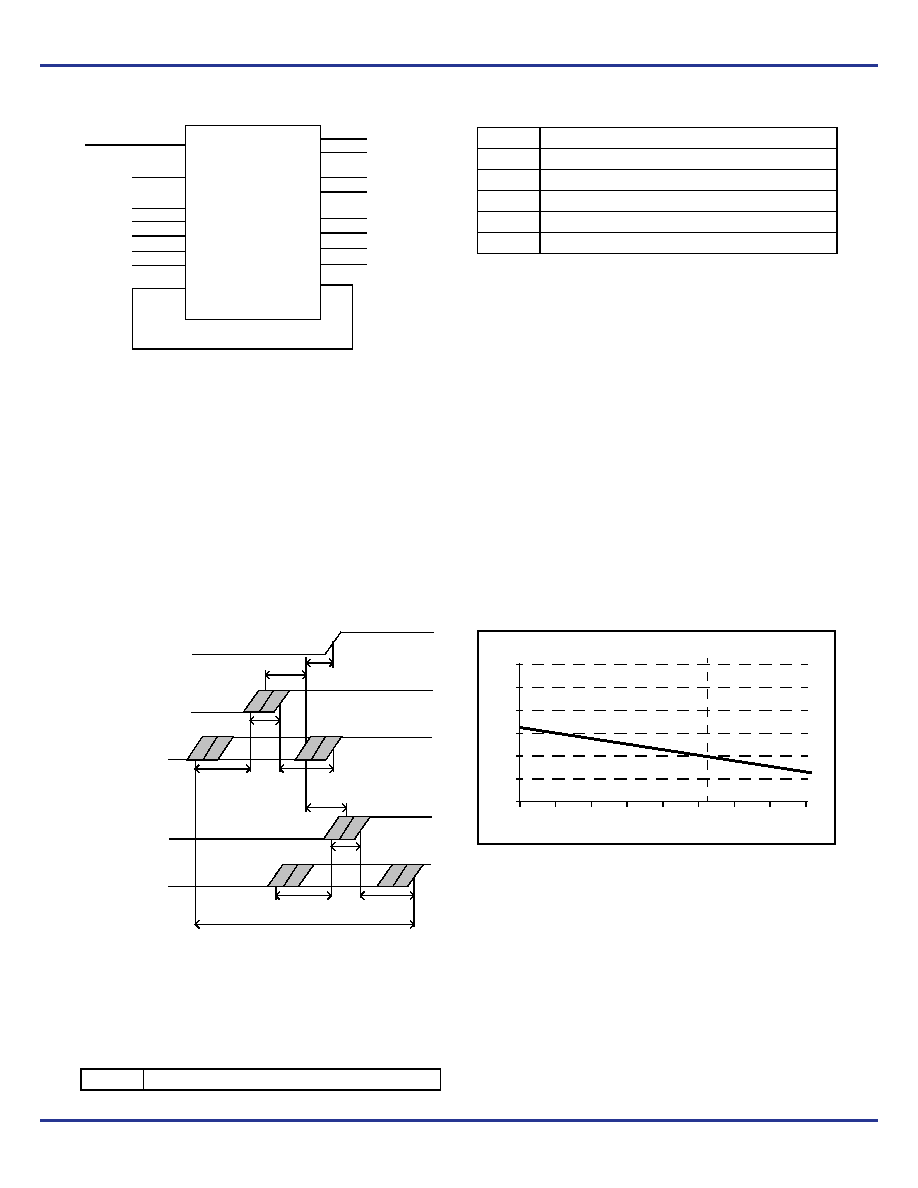- 您現(xiàn)在的位置:買賣IC網(wǎng) > PDF目錄2014 > MPC93R51AC (IDT, Integrated Device Technology Inc)IC PLL CLK DRIVER LV 32-LQFP PDF資料下載
參數(shù)資料
| 型號(hào): | MPC93R51AC |
| 廠商: | IDT, Integrated Device Technology Inc |
| 文件頁(yè)數(shù): | 11/13頁(yè) |
| 文件大?。?/td> | 0K |
| 描述: | IC PLL CLK DRIVER LV 32-LQFP |
| 標(biāo)準(zhǔn)包裝: | 250 |
| 類型: | PLL 時(shí)鐘發(fā)生器 |
| PLL: | 帶旁路 |
| 輸入: | LVCMOS,LVPECL |
| 輸出: | LVCMOS |
| 電路數(shù): | 1 |
| 比率 - 輸入:輸出: | 2:9 |
| 差分 - 輸入:輸出: | 是/無(wú) |
| 頻率 - 最大: | 240MHz |
| 除法器/乘法器: | 是/是 |
| 電源電壓: | 3.135 V ~ 3.465 V |
| 工作溫度: | 0°C ~ 70°C |
| 安裝類型: | 表面貼裝 |
| 封裝/外殼: | 32-LQFP |
| 供應(yīng)商設(shè)備封裝: | 32-TQFP(7x7) |
| 包裝: | 托盤(pán) |
第1頁(yè)第2頁(yè)第3頁(yè)第4頁(yè)第5頁(yè)第6頁(yè)第7頁(yè)第8頁(yè)第9頁(yè)第10頁(yè)當(dāng)前第11頁(yè)第12頁(yè)第13頁(yè)

MPC93R51 REVISION 4 JANUARY 31, 2013
7
2013 Integrated Device Technology, Inc.
MPC93R51 Data Sheet
LOW VOLTAGE PLL CLOCK DRIVER
Figure 3. MPC93R51 Zero-Delay Configuration
(Feedback of QD4)
Calculation of Part-to-Part Skew
The MPC93R51 zero delay buffer supports applications
where critical clock signal timing can be maintained across
several devices. If the reference clock inputs (TCLK or PCLK)
of two or more MPC93R51 are connected together, the
maximum overall timing uncertainty from the common TCLK
input to any output is:
tSK(PP) = t() + tSK(O) + tPD, LINE(FB) + tJIT() CF
This maximum timing uncertainty consists of 4
components: static phase offset, output skew, feedback
board trace delay and I/O (phase) jitter.
Figure 4. MPC93R51 Max. Device-to-Device Skew
Due to the statistical nature of I/O jitter, a RMS value (1
)
is specified. I/O jitter numbers for other confidence factors
(CF) can be derived from Table 8.
The feedback trace delay is determined by the board
layout and can be used to fine-tune the effective delay
through each device. In the following example calculation, an
I/O jitter confidence factor of 99.7% (
3) is assumed,
resulting in a worst case timing uncertainty from input to any
output of –251 ps to 351 ps relative to TCLK (VCC = 3.3 V and
fVCO = 400 MHz):
tSK(PP) = [-50ps...150ps] + [-150ps...150ps] +
[(17ps –3)...(17ps 3)] + tPD, LINE(FB)
tSK(PP) = [-251ps...351ps] + tPD, LINE(FB)
Above equation uses the maximum I/O jitter number
shown in the AC characteristic table for VCC = 3.3 V (17 ps
RMS). I/O jitter is frequency dependent with a maximum at
the lowest VCO frequency (200 MHz for the MPC93R51).
Applications using a higher VCO frequency exhibit less I/O
jitter than the AC characteristic limit. The I/O jitter
characteristics in Figure 5 can be used to derive a smaller
I/O jitter number at the specific VCO frequency, resulting in
tighter timing limits in zero-delay mode and for part-to-part
skew tSK(PP).
Figure 5. Max. I/O Jitter (RMS) Versus Frequency
for VCC = 3.3 V
Power Supply Filtering
The MPC93R51 is a mixed analog/digital product. Its
analog circuitry is naturally susceptible to random noise,
especially if this noise is seen on the power supply pins.
Noise on the VCCA (PLL) power supply impacts the device
characteristics, for instance, I/O jitter. The MPC93R51
provides separate power supplies for the output buffers (VCC)
and the phase-locked loop (VCCA) of the device. The purpose
of this design technique is to isolate the high switching noise
digital outputs from the relatively sensitive internal analog
phase-locked loop. In a digital system environment where it
is more difficult to minimize noise on the power supplies, a
Table 8. Confidence Factor CF
CF
Probability of clock edge within the distribution
MPC93R51
TCLK
QA
fref = 100 MHz
REF_SEL
PLL_EN
FSELA
FSELB
FSELC
FSELD
Ext_FB
QB
QC0
QC1
QD0
QD1
QD2
QD3
QD4
2 x 100 MHz
4 x 100 MHz
100 MHz (Feedback)
1
0
tPD,LINE(FB)
tJIT()
+tSK(O)
—t(
+t()
tJIT()
+tSK(O)
tSK(PP)
Max. skew
TCLKCommon
QFBDevice 1
Any QDevice 1
QFBDevice2
Any QDevice 2
1
0.68268948
2
0.95449988
3
0.99730007
4
0.99993663
5
0.99999943
6
0.99999999
Table 8. Confidence Factor CF
30
25
20
15
10
5
0
75
225
250
275
300
325
VCO frequency [MHz]
t JIT(
)[p
s]
ms
Max. I/O Jitter versus frequency
350
375
400
相關(guān)PDF資料 |
PDF描述 |
|---|---|
| MPC9608AC | IC CLOCK BUFFER ZD 1:10 32-LQFP |
| MPC962309EJ-1H | IC BUFFER ZD 1:5 3.3V 16-TSSOP |
| MPC96877VK | IC CLK DRIVER 1:10 SDRAM 52-BGA |
| MPC9773AE | IC PLL CLK GEN 1:12 3.3V 52-LQFP |
| MPC9850VF | IC PLL CLOCK GENERATOR 100MAPBGA |
相關(guān)代理商/技術(shù)參數(shù) |
參數(shù)描述 |
|---|---|
| MPC93R51ACR2 | 功能描述:時(shí)鐘發(fā)生器及支持產(chǎn)品 FSL 1-9 LVCMOS/LVPEC L to LVCMOS PLL Cloc RoHS:否 制造商:Silicon Labs 類型:Clock Generators 最大輸入頻率:14.318 MHz 最大輸出頻率:166 MHz 輸出端數(shù)量:16 占空比 - 最大:55 % 工作電源電壓:3.3 V 工作電源電流:1 mA 最大工作溫度:+ 85 C 安裝風(fēng)格:SMD/SMT 封裝 / 箱體:QFN-56 |
| MPC93R51D | 制造商:MOTOROLA 制造商全稱:Motorola, Inc 功能描述:LOW VOLTAGE PLL CLOCK DRIVER |
| MPC93R51FA | 功能描述:時(shí)鐘驅(qū)動(dòng)器及分配 3.3V 240MHz Clock Generator RoHS:否 制造商:Micrel 乘法/除法因子:1:4 輸出類型:Differential 最大輸出頻率:4.2 GHz 電源電壓-最大: 電源電壓-最小:5 V 最大工作溫度:+ 85 C 封裝 / 箱體:SOIC-8 封裝:Reel |
| MPC93R51FAR2 | 制造商:Integrated Device Technology Inc 功能描述:PLL CLOCK DRVR SGL 32LQFP - Tape and Reel |
| MPC93R52 | 制造商:MOTOROLA 制造商全稱:Motorola, Inc 功能描述:LOW VOLTAGE 3.3V LVCMOS 1:11 CLOCK GENERATOR |
發(fā)布緊急采購(gòu),3分鐘左右您將得到回復(fù)。